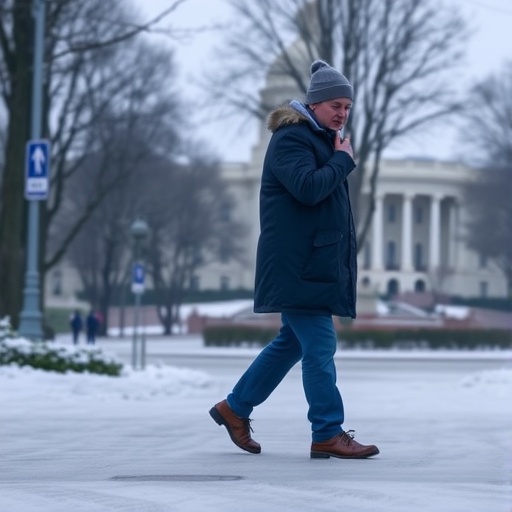Trump Government Shutdown Ignites Fury Over CDC Layoffs and Public Health Cuts While ICE Thrives
In a move that’s sending shockwaves through the medical community, the Trump administration’s ongoing government shutdown has triggered mass layoffs at the Centers for Disease Control and Prevention (CDC), slashing vital public health resources at a time when the nation can least afford it. Critics are accusing the White House of exploiting the fiscal impasse to push through deep cuts, prioritizing funding for Immigration and Customs Enforcement (ICE) and the military over disease surveillance and emergency preparedness. As federal workers go without paychecks, the U.S. public health system teeters on the brink, raising alarms about potential outbreaks and weakened responses to health crises.
- CDC Layoffs Expose Gaps in Disease Tracking and Prevention
- Trump‘s Shutdown Strategy Favors ICE Enforcement Over Health Safeguards
- Widespread Chaos Strains Local Health Departments and Frontline Workers
- Experts Sound Alarm on Long-Term Damage to U.S. Public Health Infrastructure
- Path Forward: Calls for Bipartisan Rescue of Public Health Funding
CDC Layoffs Expose Gaps in Disease Tracking and Prevention
The heart of the controversy lies in the abrupt layoffs sweeping through the CDC, America’s frontline defender against infectious diseases. Over 8,000 CDC employees—more than half the agency’s workforce—have been furloughed without pay since the government shutdown began on December 22, 2018, following a partisan standoff over border wall funding. These aren’t just administrative roles; scientists, epidemiologists, and lab technicians who monitor flu seasons, track emerging viruses like Ebola, and prepare for pandemics are now sidelined.
Dr. Tom Frieden, former CDC director under President Obama, didn’t mince words in a recent CNN interview: “This is a disaster waiting to happen. We’re blindfolding our public health guardians at the exact moment we need their eyes wide open.” Frieden’s warning underscores the real-world risks: routine inspections of food supplies have halted, potentially allowing contaminated products to reach store shelves. Vaccine distribution programs, critical for preventing measles outbreaks, are operating at reduced capacity. And the agency’s global health security teams, which collaborate with the World Health Organization on international threats, are in limbo.
Statistics paint a grim picture. The CDC’s budget for fiscal year 2019 was already strained at $7.2 billion, a figure that hasn’t kept pace with inflation or rising threats like antibiotic-resistant superbugs. During the shutdown, non-essential functions—everything from data analysis to public outreach—have ground to a halt. A report from the Government Accountability Office (GAO) highlighted that similar shutdowns in 2013 led to a 20% drop in timely disease reporting, a lapse that could have catastrophic echoes today.
Public health experts are particularly worried about the flu season, which is peaking amid the chaos. The CDC typically issues weekly updates on influenza-like illnesses, but those reports are now delayed or incomplete. In states like California and New York, local health departments are scrambling to fill the void, but they lack the federal resources for nationwide coordination. One epidemiologist in Atlanta, speaking anonymously to The New York Times, described the scene: “Labs are empty, computers are dark, and the data we need to stop the spread is piling up untouched.”
Trump‘s Shutdown Strategy Favors ICE Enforcement Over Health Safeguards
While the CDC reels from the cuts, funding for ICE remains untouched, fueling accusations of misplaced priorities under the Trump administration. ICE, tasked with immigration enforcement, continues to operate at full throttle, with its $8.1 billion budget intact and agents patrolling borders and conducting raids. This disparity has ignited bipartisan outrage, as public health funding evaporates but deportation operations surge.
According to budget documents released by the Department of Homeland Security, ICE’s detention facilities are receiving supplemental funds to house an additional 10,000 migrants, even as the shutdown drags on. Military spending, too, is shielded; the Pentagon’s $686 billion allocation ensures that defense contracts and troop paychecks flow uninterrupted. Critics, including Senate Minority Leader Chuck Schumer, argue this selective funding reveals a deliberate agenda. In a floor speech last week, Schumer thundered: “The Trump shutdown isn’t about the wall—it’s about weakening the institutions that protect everyday Americans while bolstering his hardline policies.”
The implications for public health are stark. ICE facilities, often overcrowded, have been hotspots for infectious diseases like mumps and chickenpox. Without CDC oversight, outbreaks in these centers could spill over into communities. A 2018 Human Rights Watch report documented over 200 cases of contagious illnesses in ICE custody last year alone, many going unreported due to inadequate screening. Now, with federal health inspectors furloughed, the risk escalates.
Advocacy groups like the American Public Health Association (APHA) have mobilized, launching petitions that have garnered over 500,000 signatures demanding the restoration of CDC operations. APHA President Dr. Linda Rae Murray stated in a press release: “Public health isn’t a partisan issue—it’s a national security imperative. Diverting resources to ICE while gutting the CDC endangers us all.” This sentiment echoes across the political spectrum, with even some Republican governors expressing concern over the strain on state-level health systems.
Widespread Chaos Strains Local Health Departments and Frontline Workers
The ripple effects of the government shutdown are hitting hardest at the grassroots level, where local health departments are left to plug the holes in the federal safety net. In cities like Houston and Miami, public health officials report a surge in unreported cases of foodborne illnesses and environmental hazards, as CDC field teams remain grounded. One stark example: the agency’s Environmental Health Services branch, responsible for investigating lead contamination in water supplies, has paused operations, leaving communities vulnerable in the wake of ongoing infrastructure crises.
A survey conducted by the National Association of County and City Health Officials (NACCHO) revealed that 75% of local agencies are now operating with reduced staff or borrowed funds to cover federal gaps. In rural areas, where resources are already thin, the impact is devastating. For instance, in Appalachia, CDC-supported programs for opioid overdose prevention have stalled, contributing to a 15% uptick in emergency room visits in the past month, per preliminary data from the Centers for Medicare & Medicaid Services.
Frontline workers are bearing the brunt. Furloughed CDC employees, many on their third week without pay, are turning to food banks and gig economy jobs to survive. Stories of personal hardship abound: a veteran epidemiologist in a Washington Post profile shared how she’s rationing groceries while worrying about her team’s unfinished research on Zika virus mutations. Labor unions representing federal workers estimate that the shutdown has cost the economy $11 billion so far, with public health sectors alone facing $200 million in lost productivity.
Moreover, international partners are sounding the alarm. The World Health Organization has expressed concerns over delayed U.S. contributions to global health initiatives, including the $1.2 billion pledged for Ebola response in the Democratic Republic of Congo. Without CDC input, these efforts falter, potentially allowing diseases to cross borders unchecked.
Experts Sound Alarm on Long-Term Damage to U.S. Public Health Infrastructure
As the shutdown stretches into its fourth week, experts are warning of irreversible harm to the nation’s public health backbone. The CDC’s role in everything from bioterrorism preparedness to chronic disease management is under siege, with potential consequences lingering for years. A study from the Johns Hopkins Center for Health Security predicts that prolonged disruptions could delay responses to future pandemics by up to six months, echoing the lessons from the 2014 Ebola outbreak where CDC delays cost lives and millions.
Key programs at risk include the agency’s National Center for Immunization and Respiratory Diseases, which coordinates responses to seasonal threats like H1N1. With furloughs in place, vaccine efficacy studies are on hold, and public education campaigns—vital for herd immunity—have ceased. Dr. Anthony Fauci, director of the National Institute of Allergy and Infectious Diseases, told NPR: “We’re playing with fire. Public health is built on trust and readiness; this shutdown erodes both.”
Economically, the cuts compound existing pressures. The U.S. spends just 3% of its health budget on prevention, compared to 97% on treatment, according to CDC data. Furloughs exacerbate this imbalance, potentially leading to higher healthcare costs down the line. A Brookings Institution analysis estimates that every dollar cut from public health surveillance saves pennies now but costs $10 later in outbreak control.
Political analysts point to the shutdown’s origins in Trump’s demand for $5.7 billion in border wall funding, a non-negotiable stance that’s left Democrats and moderate Republicans in a bind. House Speaker Nancy Pelosi has vowed to hold firm, but cracks are showing as public opinion sours—polls from Gallup show 52% of Americans blaming Trump for the impasse.
Path Forward: Calls for Bipartisan Rescue of Public Health Funding
Looking ahead, the path out of this crisis hinges on congressional action to end the shutdown and safeguard public health investments. Bipartisan bills are circulating in both chambers, proposing emergency appropriations for the CDC and other essential agencies. A group of 50 House Republicans, led by Rep. Brian Fitzpatrick, has joined Democrats in urging President Trump to sign a clean funding resolution, emphasizing the non-partisan nature of health threats.
Health advocates are pushing for long-term reforms, including a dedicated public health emergency fund immune to shutdowns. The Bipartisan Policy Center recommends increasing CDC funding by 15% over the next decade to address vulnerabilities exposed by the current turmoil. Meanwhile, states are stepping up: California has allocated $50 million in state funds to backfill federal gaps, a model others may follow.
Yet, uncertainty looms. If the shutdown persists, experts fear a “perfect storm” of flu season peaks, holiday travel, and international tensions could overwhelm the system. International relations may suffer too, as allies question U.S. reliability in global health diplomacy. As one CDC whistleblower put it in a leaked memo: “We’re not just furloughed—we’re forgotten, and the American people will pay the price.”
The Trump administration’s defense, via Press Secretary Sarah Sanders, insists the shutdown is temporary and that core public health functions remain active through exempted personnel. But with over 800,000 federal workers affected and public health at the forefront, the pressure mounts for a swift resolution. As negotiations resume, the nation watches anxiously, hoping to avert a deeper crisis in the fight against invisible threats that respect no borders or budgets.









